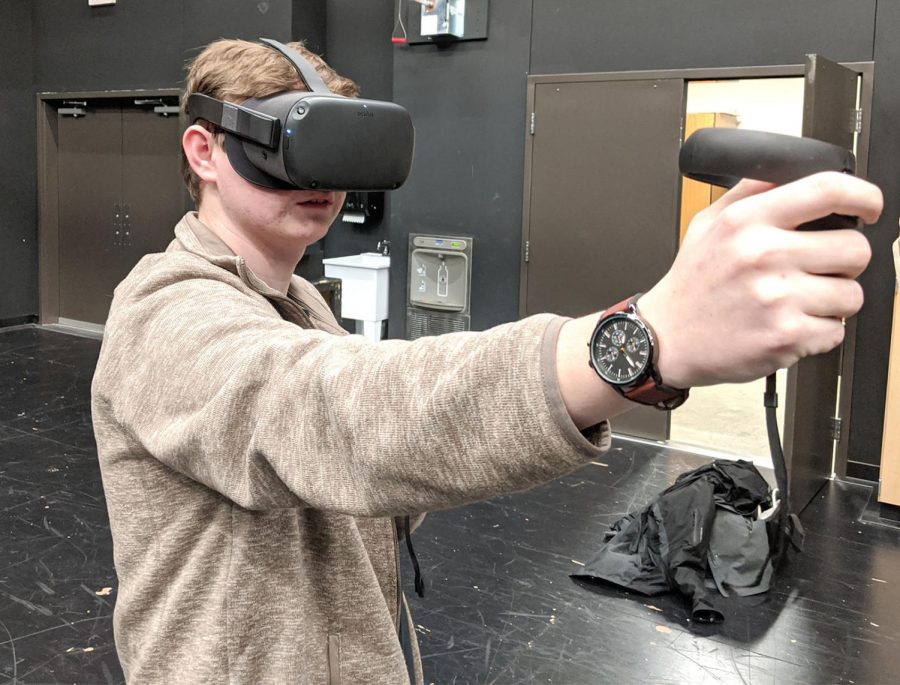Quest for the Future
A Review of the Oculus Quest and the Future of Virtual Reality Implication
February 5, 2020
Since 2012, virtual reality has struggled to get a solid grasp. From the high cost for point of entry, to the issues with motion sickness. Many have said that it is dead, but in May of 2019, Oculus, on of the leading companies in VR technology, finally found the sweet spot to open the platform to many more people with the release of the Oculus Quest.
The Oculus Quest is a stand alone VR headset, meaning people do not need to have a beefy PC to run the hardware. Along with this came the fix for the second issue, many people who already had gaming PCs did not want to drop the extra $500-$1000 for the new hardware, but the Quest came out of left field with a $399 price point for the base model. This opened up the opportunity for people who either had neither of the products, or wanted the cheaper hardware a way to get into the next major milestone in technology.
The oculus quest is in an interesting spot though, in comparison to many of the other headsets available, it is the weakest in terms of specs. But having used other headsets in the past, it is not a far cry from many other headsets. The main issue of the quest is the very limited library of games; most of the other headsets have a vast library that they can draw from on Steam. But Oculus has released a new piece of hardware called the Oculus Link, which is a system made to connect with headset and a PC wirelessly so consumers can have access to the regular set of games on steam.
One of the biggest advantages the Oculus Quest has over the competition is its sheer mobility. Not only is it the first wireless VR headset, but for the portability of the headset. Because of the wireless design, people do not need to move a PC setup to another room, set up the sensors to make a compatible play area, and recalibrate it; people can just move to a new room and draw a new guardian bound for them to use while playing. The difference is that between the hand tracking of the Quest, the freedom of wireless play, and the ability to leave the guardian bound and see everything around, Oculus is on its way to leading VR into the future of a multifaceted platform for entertainment, jobs, medical use, and education.
On top of this, the developers are using the Quest as a more experimental platform to push the tech for VR further and further. Previously consumers would have to use controllers in both hands and select things separately, but now, with a few features in beta, there is hand tracking and voice controls. While it may not seem like too much of an advancement to add hand tracking, Oculus is the first and as of right now, only company with hand tracking technology for their product. But this is just the start, while not publicly available yet, and extremely expensive, Teslasuit, an independent company is working on making a haptic suit and gloves, meaning people not only see what they are playing or experiencing, but feel it.
The future of VR seems bright, from not only the entertainment field, but from the medical and educational aspect too. Teslasuit’s main intention with their haptic suit and gloves are not for entertainment, but for the medical field, their main goal is to use their gear in tandem to help those who are in need of physical rehabilitation to to help them learn and give instant biometric feedback to medical professionals through the suit and gloves. There are also multiple different companies that are trying to start to make VR education more viable; one of the most notable is a kickstarter project called CoLearn VR, while still being funded they have big ambitions, according to the CoLearn Kickstart page “Using our platform, teachers and parents can engage their students in a virtual environment.” While it would take a while to get the project and similar ones going, it’s an inevitable evolution of the current education system, though it may take a while.
While there is not too much information on the impact of virtual reality on education yet, but what studies there are, the results are impressive. One of the studies was at the University of Maryland, where they compared students between learning though experiences in VR, and traditional learning on desktops, the students who used VR had a 28% better recall rate of the information they were taught. Then in Beijing, two groups of students were compared, one using VR experiences, and the other using traditional learning formats. When tested the students that had used the VR headsets scored on average 20% better than the students who used the traditional means of education.






